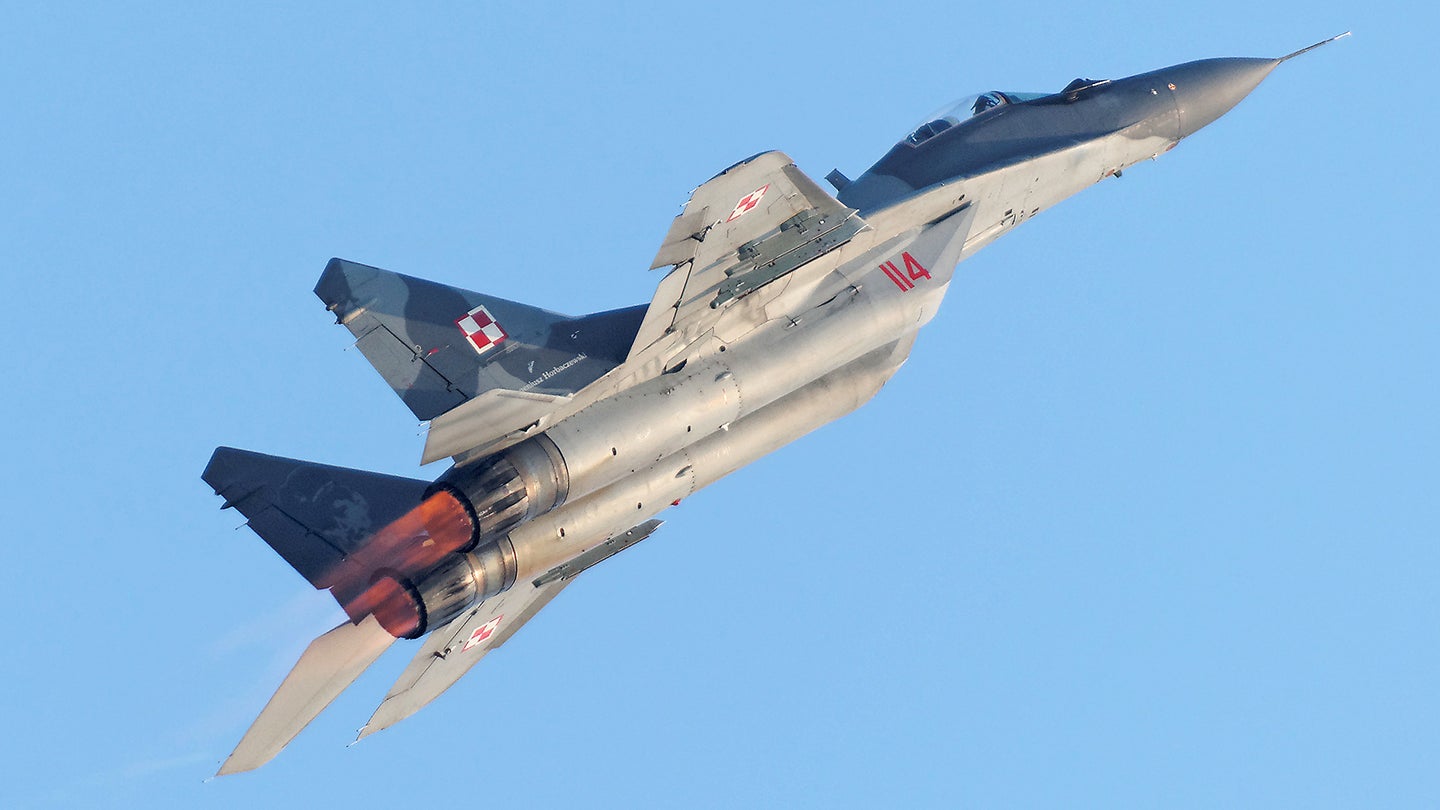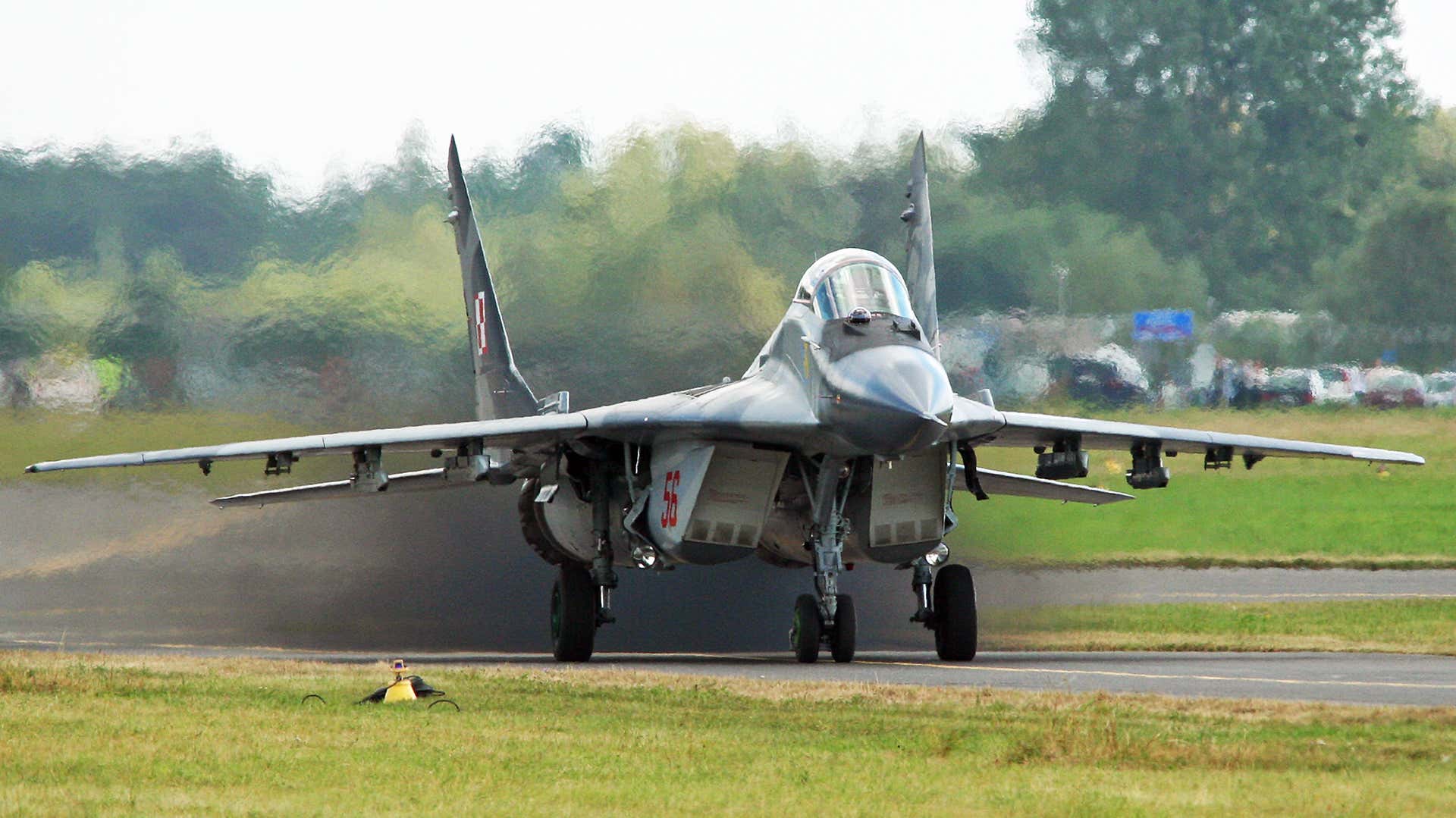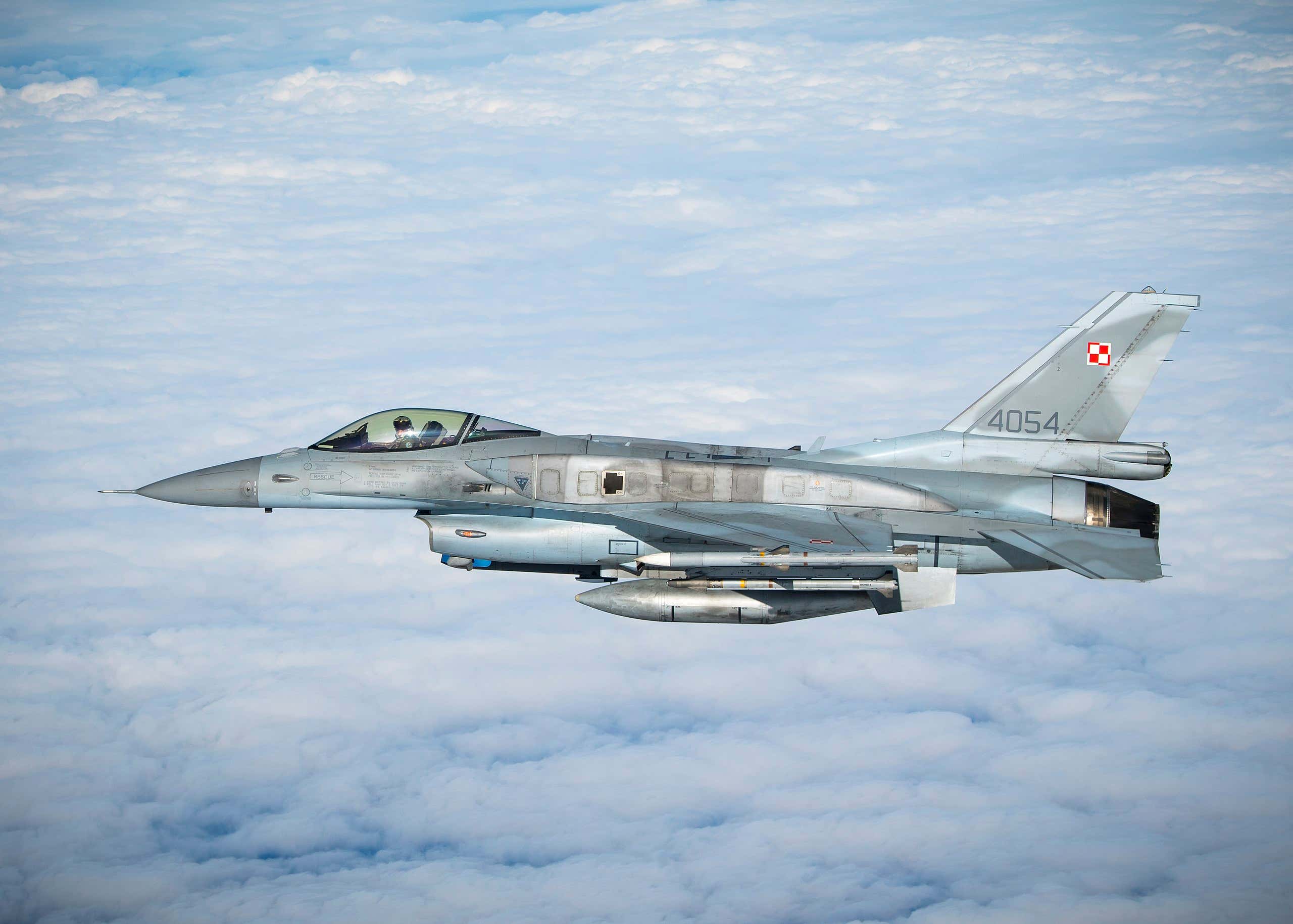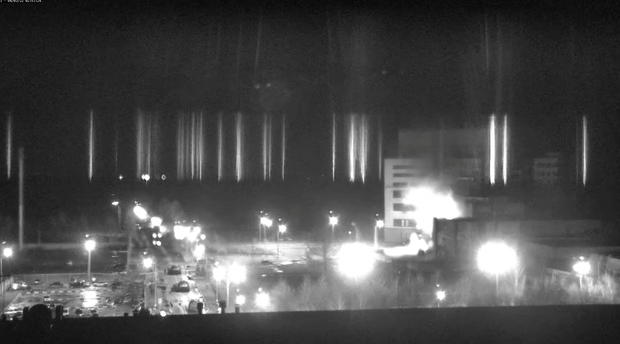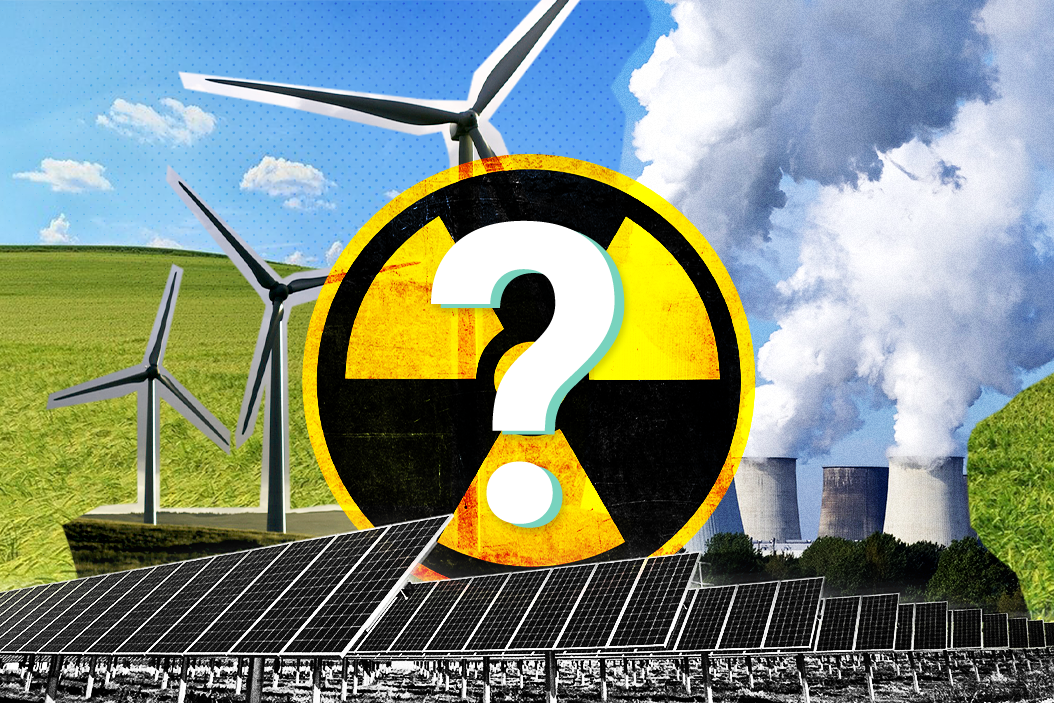The convoy slowed traffic outside the capital for hours before fading in the afternoon.
Hundreds of vehicles, led by a group of truckers, gathered at a racetrack in Hagerstown, Md., before leaving to protest on the Capital Beltway.
By Madeleine Ngo, Adam Bednar and Esha Ray
March 6, 2022
WASHINGTON — Draped in American flags and fueled by anger, hundreds of vehicles led by a group of truckers encircled the nation’s capital on Sunday, hampering traffic outside the city for hours by driving at slower speeds to protest Covid-19 mandates.
The convoy of vehicles — dozens of trucks, along with minivans, motorcycles, pickup trucks and hatchbacks, with many displaying signs that read “Freedom” — aimed to complete two loops on Interstate 495, a 64-mile highway known as the Capital Beltway, before returning to a staging area in Maryland, with plans to potentially ramp up the demonstration in the coming days. But by the second time around, the vehicles appeared to be so spread out that the congestion took on the feel of a weekday morning commute, before opening up in the afternoon.
Although it was unclear whether the caravan would ultimately enter Washington, D.C., this week, organizers said they did not want people to drive into the capital on Sunday out of fears that some participants could turn it into a chaotic event reminiscent of the Jan. 6 attack on the Capitol. They also wanted to avoid a confrontation with law enforcement after dozens of people protesting in Ottawa, the Canadian capital, were arrested last month.
Christopher Rodriguez, the director of the District of Columbia Homeland Security and Emergency Management Agency, said the protest did not result in any major disruptions to the city’s transportation routes on Sunday, although he said that it was a “fluid and unpredictable event.”
He added that the city government was urging residents to prepare for increased traffic levels around the region and said he expected more convoys from across the country to join in the next few days. The city’s request to extend National Guard resources was also approved through Wednesday, and 249 personnel and 15 heavy vehicles remain to help respond to any roadway disruptions. Mr. Rodriguez said no citations were issued, and a Virginia State Police spokeswoman said no tickets were given to members of the convoy.
The group behind the caravan, the People’s Convoy, has been demanding an end to the national emergency that was first declared by former President Donald Trump in March 2020 and was recently extended by President Biden. The protesters have also called for congressional hearings into the origin of the pandemic and an end to government rules requiring masks and vaccinations. But those demands have been undercut by the reality that many U.S. states have already started rolling back restrictions as virus cases and deaths have ebbed.

convoy traveled down I-70 to the Capital Beltway on Sunday.Credit...Kenny Holston for The New York Times

And the Centers for Disease Control and Prevention issued new guidance in late February suggesting that the vast majority of Americans could stop wearing masks. Many medical experts say vaccine mandates are effective in persuading more people to get their shots, which they say is essential to helping prevent the spread of the virus.
Although the People’s Convoy was one of several groups inspired by the Canadian protests against pandemic measures that disrupted the capital of Ottawa for three weeks, many in the group appeared to be aligned with far-right organizations and activists. On Saturday, organizers with the People’s Convoy shared a supportive post from a prominent QAnon account on its official Telegram channel.
The convoy first departed from Adelanto, Calif., on Feb. 23 with plans to end the demonstration in the Washington area. Before Sunday, the truckers gathered at a racetrack in nearby Hagerstown, Md., about 70 miles northwest of the capital, converging with other drivers and their supporters.
As the convoy made its way from the Hagerstown Speedway to the highway on Sunday morning, a winding road that was approximately five miles was lined with people waving flags.
By late morning, the convoy, traveling east on Interstate 70 between Hagerstown and Frederick, had caused significant traffic slowdowns. There was a wreck, though it was unclear what caused it. At other points, drivers pulled over to stop and wave flags. As the convoy slowly progressed toward I-495, a handful of officers from the Maryland State Police could be seen, in some cases helping to clear flags from the road. Many overpasses were crowded with onlookers waving flags, though some motorists passing the convoy appeared frustrated at the congestion.
In the early afternoon, the convoy continued to slow traffic, but the vehicles were so spread out — across five lanes — that the sense of a mass presence faded, though the traffic itself lingered. At one point just before the vehicles reached I-495, car speeds reached about 70 miles per hour, but then traffic tightened again, with cars settling into a rolling backup, going between 25 m.p.h. to at times less than 10.
Although overpasses later in the route contained fewer supporters of the convoy, many still waved flags and held signs thanking the truckers or expressing support for Mr. Trump. Few vehicles of the Maryland State Police were seen, but when the route crossed into Northern Virginia, a heavy police presence was evident, with Virginia troopers in patrol cars and on motorcycles.
Overall, the first loop took nearly two hours to complete.
During the second loop, vehicles in the convoy seemed to be completely scattered, and more counterprotesters appeared on overpasses, with one waving a sign that read “Go Away.”

Convoy participants and their supporters in Hagerstown on Saturday.Credit...Kenny Holston for The New York Times

Steve Girard, 59, who joined the convoy about five days ago in Indiana with his 1998 white Chevy van, said he felt compelled to join the protest since he wanted to see an end to Covid-19 vaccine and masking mandates. While on the road, Mr. Girard said he felt encouraged to see some supporters waving at the group, and he hoped that the demonstration would lead to meetings with lawmakers and the end of the national emergency declaration.
“There is no emergency,” said Mr. Girard, a resident of Lancaster, Pa. “We don’t need to get a shot just because a politician says we need to get a shot.”
Mr. Girard said he was particularly angry over the fact that his 7-year-old granddaughter had to wear a mask while riding the school bus.
“Why should a child have to wear a mask?” Mr. Girard said. “Kids aren’t getting sick.”
According to data from the C.D.C., there have been at least 865 reported deaths involving Covid-19 in children under 17, and more children were hospitalized during the surge driven by the highly transmissible Omicron variant than at any other point in the pandemic.
William Smink, 31, who routinely commutes from Baltimore to Washington for work, said the convoy didn’t have a big impact on him. Mr. Smink, who works for a local TV station, said that while his commute, which typically takes 45 minutes, was derailed by the truckers and ended up taking about an hour, he still made it to work on time.
“For the most part, they were very respectful,” he said. “If there was a big enough space, in between the trucks, they were letting people merge in and out of the lanes. They were just driving well below the speed limit.” He would go about half a mile, he said, and then everybody would slam on their breaks. Then, they would crawl for another mile, and then traffic would pick back up.
Before the protesters departed on Sunday morning, Brian Brase, one of the convoy’s organizers, said before a crowd of gatherers that they intended to show “truly how large we are.” Although Mr. Brase said the convoy did not plan to enter the capital “at this time,” he did not rule out the possibility.
“We’re not going to shut anything down today. We’re just going to do a convoy so that they can see that we’re in their backyard and that we are huge,” Mr. Brase said. “We’re doing this to let them know that we are very serious.”
Ron Dimaline, 67, a pastor and retired coal industry worker from Pike County, Ky., started riding in his dump truck with the convoy two days ago. On Sunday morning, he said he had grown frustrated with the rising cost of gas and feared that the United States was drifting toward communism. But anti-Covid measures particularly irritated him.
“Let people alone. If you want to wear a mask, wear a mask,” he said. “I’ll stay away from you.”
Giulia Heyward contributed reporting.
A version of this article appears in print on March 7, 2022, Section A, Page 14 of the New York edition with the headline: Truckers Protest Mandates Even as Covid Rules Are Eased.
Far-right “People’s Convoy” arrives outside Washington D.C.
Jacob Crosse
WSWS.ORG
Over the weekend, the US-based, far-right “People’s Convoy,” ostensibly organized in opposition to rapidly disappearing COVID-19 public health measures, arrived in the Washington D.C. area, without causing any noticeable traffic problems or blockades.
Despite significant support from far-right sections of the ruling class, including in favorable reports, interviews with rally organizers, daily coverage on Fox News and on fascist former Trump adviser Steve Bannon’s “War Room” podcast, the convoy—as of this writing—appears to have only drawn in about 1,000 vehicles, fewer than half of them heavy trucks.
While organizers attempted to paint the convoy as an organic expression of working class resistance to the “bio-medical security state,” in the words of Florida Governor Ron DeSantis, the relatively small convoy was dominated by the petty bourgeoisie not the working class. Most of the vehicles were pickup trucks, SUVs and recreational vehicles, along with a few hundred semi-tractors, festooned with American and Canadian flags, as well as pro-Trump slogans.
The profit-driven, anti-scientific message espoused by the “People’s Convoy” was to declare the pandemic “over,” even though it continues to kill more than a thousand people a day, adding to the death toll of nearly 1 million in the US alone. This is linked to conspiracy theories that the pandemic is a hoax devised by the government and the media, and that the vaccination campaign is secretly inserting computer chips into people’s bodies for nefarious purposes.
This anti-science, anti-public health message is deeply unpopular. Despite an unrelenting media and political campaign, spearheaded by the Biden administration, which has fully embraced Trump’s “herd immunity” policies, a majority of the US population still supports mask mandates to stem the spread of the coronavirus. According to a February CBS News-YouGov poll, 56 percent of respondents said their state should require the wearing of masks inside, including 57 percent who said masks should be required in schools.
The cross-country plague convoy left Adelanto, California, on February 22, picking up a few hundred COVID-19 denialists and far-right supporters along the way. About 5,000 people gathered on Friday night at the Hagerstown Speedway, a racetrack about 80 miles outside of the US capital. On Sunday, the convoy left the track and headed toward Washington, where they proceeded to spend about four hours driving twice around the Capital Beltway, a 64-mile stretch of interstate that surrounds the D.C. metro area.
On Sunday, a few dozen people gathered on various overpasses on the Beltway either in support or against the convoy. While various social media groups in support of the convoy attracted thousands of followers online in the past few weeks, events in Ukraine have caused divisions within the ultra-right movement, with some backing out due to fear that the convoy is a “false flag” operation, designed to entrap Trump supporters.
Last month the Department of Homeland Security (DHS) leaked a memo warning that the convoy could cause significant traffic disruptions, gridlock and lead to possible counter-protests. The memo warned that the convoy would seek to emulate the occupation of downtown Ottawa, the Canadian capital, and could surround the U.S. Capitol. Fearing a possible repeat of January 6, 2021, the fascist attack on the Capitol during the counting of electoral votes in the presidential election, the Pentagon authorized the deployment of 700 National Guard soldiers and 50 large vehicles, while steel security fencing was erected around the Capitol complex.
While organizers of the convoy had sought to create disruption, on Sunday roughly two hours into their loop around the Capital Beltway the convoy became dispersed with normal traffic, causing no delays.
“We’re not even sure we can call it a convoy anymore because it’s so dispersed among routine traffic at this point,” Virginia State Police spokeswoman Corrine Geller told the Washington Post. The official webpage of the “People’s Convoy” noted that participants will continue to mass at the Hagerstown Speedway.
The “People’s Convoy” has so far failed to have the same impact as its Canadian counterparts, an indication that the US ruling class and the Biden administration will not brook any disruptions to the drive toward imperialist war with Russia. The Post reported on Sunday that the Pentagon had authorized extending the presence of National Guard soldiers in D.C. through Wednesday.
In an interview with NBC News , convoy co-organizer and Trump operative Brian Brase stressed the convoy will not actually enter the District of Columbia. Brase, who has admitted to being in constant contact with law enforcement, instead said participants will continue to drive around the Beltway every day as part of an effort to force lawmakers to give in to the convoy’s nebulous and evolving demands.
“What the People’s Convoy’s looking for is, we’re looking for immediate end to the state of emergency,” Brase told NBC. “We don’t believe there is an emergency any longer.”
Like the Canadian convoy, the US convoy has been a top-down operation, with comparatively few actual working truck drivers, organized and funded by the same forces behind former President Donald Trump’s failed coup. Leading Trump co-conspirator and former Trump aide Peter Navarro boasted on Bannon’s War Room podcast this past Friday that the convoy and its “truckers” are “making an incredibly important statement about these failed vaccine mandates.”
“And we must press that through,” added Navarro.
Demonstrating the support the convoy has within the “America First” wing of the Republican Party and by extension the ruling class as a whole, on Monday, Republican representatives Matt Gaetz (Florida), Thomas Massie (Kentucky) and Marjorie Taylor Greene (Georgia) will be hosting a “Trucker Round Table” with rally organizers, where they will combine the homicidal demands of the opponents of vaccination with the incitement of fascistic violence on behalf of Trump.
RAW STORY
HAGERSTOWN, Md. — Thousands of angry conservative supporters of the truckers convoy rallied at a speedway in rural Maryland 60 miles outside of the Capital Beltway on Saturday evening, torn between the imperative for militant action to reject COVID measures and the recognition that disruption will likely result in legal repercussions.
Addressing supporters filling the stands at Hagerstown Speedway, organizer Brian Brase said leaders “are currently right now working on another location that when we move to puts us within just a few miles of the Beltway,” while imploring them not to go into the District of Columbia.
“They are waiting for us to show up, and it’s a trap,” Brase said.
Brase said organizers expected to hold meetings with members of Congress at the new location near the Beltway, adding, “We will not leave until we get what we ask for.” He listed a number of demands that are unlikely to be met by the current Congress under Democratic leadership, but will likely provide talking points for the Republicans’ goal of regaining control of the legislative branch during this year’s midterm elections.
“That’s why we don’t go anywhere, sir, until they actually start to do something,” Brase said, responding to a man who shouted out that lawmakers are “liars.” “That’s why we sit there in their backyard and we wait until they legitimately drop the state of emergency, they drop the vaccine mandates, and they begin the process of bipartisan investigations… to find out the transparent version of the pandemic’s origins, and ask who is responsible for screwing this up so badly.”
From a practical standpoint, Brase urged rallygoers to extend their hotel stays in Hagerstown through Sunday night. During his speech, Brase invited supporters to a meeting at the speedway at 8 a.m. on Sunday to discuss plans for the day. The Washington Post reported late Saturday that Brase told the newspaper the convoy will circle the Beltway twice on Sunday; Brase did not mention the plan during his remarks at the speedway on Saturday evening. (On Sunday morning at about 9 a.m., two sources on the ground at the Hagerstown Speedway — Left Coast Right Watch and photojournalist Zach D. Roberts — confirmed that the truckers are mobilizing to make two loops around the Beltway.)
Before Brase pleaded with supporters to stay out of DC, another organizer, Mike Landis vowed: “My truck with that flag will go down Constitution Avenue.” In response, the crowd broke into a chant of “USA! USA! USA!”
Leigh Dundas, an antivaccination lawyer who played a key role in assembling the convoy, also warned against going into DC in a statement issued on Saturday. On March 3, an admin for the People’s Convoy posted a statement on the official Telegram channel indicating that the group had “cut ties” with Dundas’ organization, Freedom Fighter Nation, and would “no longer be affiliated with” her. The statement also said, “We only have like-minded individuals in our organization and are continually rooting out people that do not have the best interest of the convoy in mind.”
In a statement posted on the Freedom Fighter Nation website on Saturday that appears to replicate a letter sent from Dundas to Brase, Landis and two other organizers, Dundas wrote: “Gentlemen, I feel it is my duty to reiterate to you that to the extent that you are participating in a convoy whose final destination is Washington, DC proper, the Beltway, or areas quite proximal to these destinations or roadways, you are making an immeasurable mistake. The goodwill and strength of the message that has been built will be eviscerated, and more importantly, shutting down transportation routes whether intentionally or accidentally in the Washington, DC area will undoubtedly put people’s lives in danger.”
A note attached to the statement indicated that the letter was written in the late evening of March 2 and early morning hours of March 3 “after receipt of information,” but was not sent to the organizers until March 4 — after the People’s Convoy had officially cut ties with her.
“Any escalation of a situation between the People’s Convoy (and other participants) and law enforcement agencies and/or the National Guard (should any escalation occur), could rapidly proceed to harrowing proportions, and leave a lasting stain on this movement and you gentlemen in particular,” the statement continued.
The statement authored by Dundas on the Freedom Fighter Nation is also attributed to Ray Alexander, who is described as a “former Naval commander.” According to a footnote attached to the statement, Alexander “did briefly continue onward volunteering his time as the advance team (between Wednesday evening and this Friday morning), in an effort to transfer the baton smoothly on the logistics and venue-sourcing front.”
Adding further confusion about the alleged differences that led to the parting, Dundas’ personal assistant, Maureen Steele, has remained involved with the convoy, and spoke at the rally at Hagerstown Speedway on Saturday evening.
Josh Yoder, an airline pilot who has been speaking at the nightly rallies held by the People’s Convoy, also cautioned against going into DC.
“I can tell you that right now as I speak there are traps being laid in DC,” Yoder said during the rally on Saturday evening. “I’ve been on the phone today with federal agents in DC. And I am pleading with all of you: We cannot go into the District of Columbia. It cannot happen. They are telling me anyone who comes in there with the convoy is probably going to be detained. There’s going to be big problems. I’m asking you: Please keep this peaceful. Keep it law-abiding. And do not go into the District of Columbia. I’m begging you.”
Organizers are also worried about bad actors within their own ranks. On Saturday afternoon, right-wing provocateurs Jacob Wohl and Jack Burkman were kicked out of the speedway grounds after trying to mobilize people to go to DC that day.
With COVID restrictions easing as case counts drop, the complaints voiced by convoy participants have expanded into a full panoply of conservative grievances, including anger about inflation, opposition to government overreach in general, and lack of faith in President Biden’s leadership on foreign policy.
In a segment for former White House strategist Steve Bannon’s podcast, a trucker identified as “Stan” said the convoy participants want to go back to an earlier time that was somehow more free.
“Things that have happened in this country in the last year — we just want to go back to the way it was before the COVID stuff,” Stan said. “Personally, me, I’d like to go back before 9/11, the Patriot Act. Things like that. It’s just very tyrannical type stuff. It’s government overreach. And that’s what we’re all about. Sure, the mask things and the shots and all this, they’re the… easy thing to talk about, but it’s all the other things behind the scenes…. We have freedom. They’re trying to take it away, and we’re gonna stop ’em. We’re gonna take our freedom back to where it was before.”
Celebratory scene at truckers convoyyoutu.be
Following the speeches at the speedway, supporters retreated to the parking lot where they prepared to unfurl a giant American flag. The air was charged with anger and celebration as a row of rigs revved their engines and blasted their horns, with fireworks streaking into the sky. Supporters facing the rigs enthusiastically waved signs and chanted, “Let’s go Brandon,” a euphemism for “F*ck Joe Biden.”
Near the entrance to the speedway, a young man held up a cell phone and filmed the scene, exclaiming, “There must be thousands of people here. This is what it looks like when America stands up.”
Vehicles were scattered around the parking lot in random configurations as rallygoers held cell phones aloft in the dark to record the spectacle. A volunteer directing traffic at the entrance yelled angrily at a van driver attempting to leave the premises and at a man driving a flatbed truck who was attempting to turn into the driveway. Both failed to heed directions before eventually yielding. Pickup trucks sped down National Pike, a two-lane highway, with flags fluttering in the wind, as pedestrians carefully picked their way along the shoulder packed with cars.
A young man from a truck called out, “F*ck you, Biden!”
It was a cheerful greeting to compatriots, albeit strangers, and the throng of people walking to their cars responded in kind, hooting in agreement.
Truckers convoy organizer Brian Brase,
March 06, 2022

The average semi-truck gets about 6.5 miles per gallon, said ArrowTruck.com in an advice post for how to save fuel. TopMark also noted that claims that there are trucks that can somehow get 10 miles per gallon are "a fantastic pipedream."
At a time when the Fox network and Republican politicians are complaining about the high price of fuel, the trucker convoy is showing that the cost of fuel clearly isn't bad enough to deter their driving protest.
As some noticed, the convoy is going to be forced to pay out thousands for just a day of protest. The lowest price for diesel in Hagerstown, Maryland, is $3.93 per gallon, according to GasBuddy, and the highest is $4.56. So, at an average of $4.25 per gallon and the average trip from Hagerstown to I-495, and around the Beltway and back to Hagerstown, is about 184 miles.
That means each drive from Hagerstown, a loop around the Beltway, and back to Hagerstown will cost about $120.32 each trip for one truck. If there are 100 trucks that's over $12,000 in diesel fuel.
Given the disasters abroad, some are asking how many refugees fleeing Ukraine could get hot meals from the World Central Kitchen for that amount.
The truckers intend to increase the number of loops they will make each day. That means, on Monday, they will travel 248 miles for two loops. Day three will be 312 miles. By the end of the week, each truck in the convoy will be using up 440 miles in diesel, which will cost them approximately $287.69 for the trip. For just 20 trucks that's over $5,700. The convoy has raised over $1.5 million. If they count the cost for their return home, that means they're likely to run out of cash fairly quickly.
On Sunday, some of the group got lost and separated, which likely caused them to use up more fuel.
Meanwhile, the Right Side Broadcasting Network showed a three-hour video watching cars driving on the Beltway. Part. of the shot was blurred by the fence it sat behind.
See the mockery of the convoy below:



